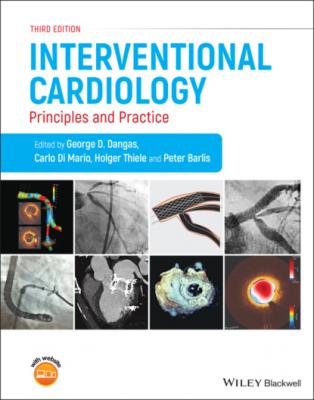Interventional Cardiology. Группа авторов
Читать онлайн.| Название | Interventional Cardiology |
|---|---|
| Автор произведения | Группа авторов |
| Жанр | Медицина |
| Серия | |
| Издательство | Медицина |
| Год выпуска | 0 |
| isbn | 9781119697381 |
Acute coronary syndromes: identification of the culprit plaque and distinction rupture/erosion
The unique ability of OCT to identify small plaque rupture and to distinguish rupture and erosion offers a major added value in the characterization of patients with ACS before treatment (Figure 9.3). Johnson et al. described plaque rupture as the presence of a disrupted discontinuous fibrous cap overlying a lipid core. It is typically associated with a vessel wall cavity, result of the embolization of its necrotic core. Plaque rupture can be observed in a variety of clinical scenarios and often thrombi are found on rupture edges. Plaque rupture, TCFA, and red thrombus are more frequent in patients with ST‐elevation myocardial infarction (STEMI). Additionally, the size of the ruptured cavities was greater and an aperture opposite to the flow direction was more frequent in patients with STEMI [44]. OCT also showed differences in the morphology of ruptured plaques in non‐STEMI and asymptomatic coronary artery disease (CAD) [45]. Pathologic studies suggest that ruptures do not necessarily lead to ACS, and ruptures can heal and cause plaque progression. Using OCT, healed plaques can be identified as multiple layers of different optical densities overlying a large necrotic core [46].
Figure 9.3 Plaque classification algorithm by optical coherence tomography (OCT). Plaque rupture is defined as the presence of fibrous cap discontinuity associated to a cavity inside the plaque. Definite OCT erosion is identified by the presence of attached thrombus overlying an intact and visualized plaque, whereas probable OCT erosion is defined by: (i) luminal surface irregularity at the culprit lesion in the absence of thrombus; or (ii) attenuation of underlying plaque by thrombus without superficial lipid or calcification immediately proximal or distal to the site of thrombus. A calcified nodule protruding into the lumen with partial cap disruption may also lead to thrombus formation and plaque instability.
Source: Jia et al. 2013 [47]. Copyright (2013), with permission from Elsevier.
Although plaque rupture is the most common cause of ACS, pathology has shown that more than 20–30% of events are caused by plaque erosion, or more rarely by thrombosis triggered by the presence of superficial protruding calcific nodules shown on OCT (Figure 9.3). The subtle changes induced by erosion can be detected and confirmed in vivo only by OCT. Plaque erosion can be suspected in the presence of different patterns: white thrombus on an intact fibrous cap, lack of thrombus with an irregular lumen surface, overlying thrombus with underlying plaque without superficial lipid or calcification immediately proximal or distal to the site of thrombus [47]. The characteristics of 51 culprit plaques and 216 nonculprit plaques were analyzed in 51 ACS patients (37 men; mean age 58.7 years). Compared with patients with culprit plaque rupture, ACS patients with culprit plaque erosion had a smaller number of nonculprit plaques. A prospective series of 822 patients suggests that people with plaque erosion tend to be younger, with a relatively high rate of post‐menopausal women and smokers, without traditional coronary risk factors, with lack of multi‐vessel disease. Low lesion severity, larger vessel size and nearby bifurcation were significantly associated with plaque erosions [48,49]. The importance of OCT in detecting plaque disruption and categorize plaque morphology in vivo [47] could aid in the derivation of treatment strategies [50], with no PCI required in non critical stenoses with plaque erosions.
Guidance of percutaneous coronary intervention
The widespread application of a non‐occlusive technique using monorail OCT catheters, the high pullback speed allowed by newer generation FD‐OCT systems, the introduction of coregistration techniques and the availability of semi‐automatic measurements have made OCT a potential alternative for guidance of percutaneous coronary interventions (PCI), overcoming drawbacks of coronary angiography and avoiding the difficulties in interpretation and quantification of IVUS (Figure 9.4). However, it is very important to understand that OCT and IVUS are not interchangeable techniques; they have advantages, limitations, and differences in the way the procedure is guided via online measurements during the PCI procedure.
Figure 9.4 Optical coherence tomography in coronary interventions. (a) Strut malapposition. Malapposed struts can be seen between 12 and 6 o’clock. (b) Intracoronary thrombus formation during coronary intervention. (c) Edge dissection. (d) Tissue prolapse. (e) Neointimal coverage of stent struts in the follow‐up. (f) Intimal coverage of malapposed struts (arrow). (g) Neointimal hyperplasia. (h) In‐stent restenosis. (i) Bioabsorbable vascular scaffold (BVS). Note BVS struts are transparent to light. (j) BVS in the follow‐up.
Because of the sharp delineation of lumen contours, OCT easily provides automatic lumen measurements (Figure 9.5). Accurate measurement of the reference lumen dimensions allows for optimal stent diameter selection, while the precise identification of the longitudinal extent of the atherosclerotic plaque facilitates selection of the most appropriate stent length and landing zones. The visualization of stent expansion permits optimization with high pressure post‐dilatation, in the case of focal underexpansion readily demonstrated in the online lumen profile maps of modern OCT systems. In a recent study, which compared FD‐OCT, IVUS, and quantitative coronary angiography [51], the mean minimum lumen diameter measured by quantitive coronary angiography (QCA) was smaller than by OCT, which was smaller than that by IVUS, a result consistent with a previous report [52]. Using a phantom model, investigators showed that mean lumen area (MLA) according to FD‐OCT was equal to the actual lumen area of the phantom model while IVUS overestimated the lumen area and was less reproducible than FD‐OCT. In addition to cross‐sectional measurements, FD‐OCT also provides accurate longitudinal measurements [53]. The main difference with IVUS, however, is the inability of OCT to measure the media‐to‐media diameter in most cases, with the rare exception of some distal reference segments with very small plaque burden and vessel diameter.
